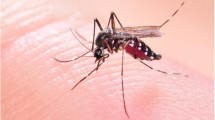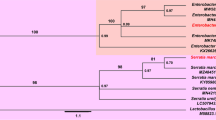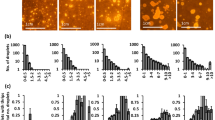Abstract
The Mediterranean fruit fly Ceratitis capitata (Wiedemann) (Diptera: Tephritidae) (medfly) is a polyphagous pest of global economic importance. This study tested the suitability of two different adhesive powders, EntostatTM and an adhesive metal powder, as insecticide carriers for use in a lure and kill pest control system, that would allow the auto-dissemination of insecticide from males to female conspecifics through sexual interactions. Lethal time to 50 % (LT50) irreversible knockdown was calculated for male and female medfly artificially contaminated by five different doses of spinosad insecticide, formulated with each adhesive carrier powder. The formulations with adhesive metal powder resulted in a rapid knockdown of medfly which was too fast for use in an auto-dissemination system. Entostat powder with 2 % spinosad gave the best performance, allowing sufficient time for transfer between conspecifics before knockdown and, therefore, allowing the most auto-dissemination (LT50 4 h). Knockdown through transfer of powder from males to females during mating was confirmed, with knockdown at 70–78 % for mated females, with a LT50 of <40 h. These results indicate that Entostat powder is a suitable carrier powder for the development of an insecticidal auto-dissemination control system.


Similar content being viewed by others
References
Arita LH (1982) Reproductive and sexual maturity of the Mediterranean fruit fly, Ceratitis capitata (Wiedemann). Proc Hawaiian Entomol Soc 24:25–29
Armsworth CG, Baxter IH, Barton LE, Poppy GM, Nansen C (2006) Effects of adhesive powders on the mating and flight behavior of Mediterranean fruit fly (Diptera: Tephritidae). J Econ Entomol 99:1194–1202
Armsworth CG, Rogers CD, Barton LE, Soares C, Poppy GM (2008) Uptake of adhesive powders from lure stations by Mediterranean fruit fly (Diptera: Tephritidae). J Appl Entomol 132:45–53
Barton LE, Armsworth CG, Baxter IH, Poppy GM, Gaunt LF, Nansen C (2006) Adhesive powder uptake and transfer by Mediterranean fruit flies (Diptera: Tephritidae). J Appl Entomol 130:257–262
Baxter IH, Howard N, Armsworth GC, Barton LE, Jackson C (2008) The potential of two electrostatic powders as the basis for an autodissemination control method of Plodia interpunctella (Hübner). J Stored Prod Res 44:152–161
Benelli G, Canale A, Flamini G, Cioni PL, Demi F, Ceccarini L, Macchia M, Conti B (2013) Biotoxicity of Melaleuca alternifolia (Myrtaceae) essential oil against the Mediterranean fruit fly, Ceratitis capitata (Diptera: Tephritidae), and its parasitoid Psyttalia concolor (Hymenoptera: Braconidae). Ind Crop Prod. doi:10.1016/j.indcrop.2013.08.006
Biondi A, Mommaerts V, Smagghe G, Viñuela E, Zappalà L, Desneux N (2012) The non-target impact of spinosyns on beneficial arthropods. Pest Manag Sci 68:1523–1536
Birch ANE, Begg GS, Squire GR (2011) How agro-ecological research helps to address food security issues under new IPM and pesticide reduction policies for global crop production systems. J Exp Bot 62:3251–3261
Blay S, Yuval B (1999) Oviposition and fertility in the Mediterranean fruit fly (Diptera: Tephritidae): effects of male and female body size and the availability of sperm. Ann Entomol Soc Am 92:278–284
Bonizzoni M, Zheng L, Guglielmino CR, Haymer DS, Gasperi G, Gomulski LM, Malacrida AR (2001) Microsatellite analysis of medfly bioinfestations in California. Mol Ecol 10:2515–2524
Briceño RD, Ramos D, Eberhard WG (1996) Courtship behavior of male Ceratitis capitata (Diptera: Tephritidae) in captivity. Fla Entomol 79:130–143
Bull RM (2011) Lethal male-female transfer of insecticide from a fipronil-based male annihilation device by Bactrocera tryoni (Froggatt). In: Proceedings of the 8th international symposium on fruit flies of economic importance, Valencia, 2010, pp 261–269
Bürgi LP, Mills NJ (2010) Cold tolerance of the overwintering larval instars of light brown apple moth Epiphyas postvittana. J Insect Physiol 56:1645–1650
Canale A, Benelli G, Conti B, Lenzi G, Flamini G, Francini A, Cioni PL (2013) Ingestion toxicity of three Lamiaceae essential oils incorporated in protein baits against the olive fruit fly, Bactrocera oleae (Rossi) (Diptera Tephritidae). Nat Prod Rep. doi:10.1080/14786419.2013.784871
Chueca P, Montón H, Ripollés JL, Castañera P, Moltó E, Urbaneja A (2007) Spinosad bait treatments as alternative to malathion to control the Mediterranean fruit fly Ceratitis capitata (Diptera: Tephritidae) in the Mediterranean Basin. Pestic Sci 32:407–411
Diamantidis AD, Carey JR, Nakas CT, Papadopoulos NK (2011) Population-specific demography and invasion potential in medfly. Ecol Evol 1:479–488
El-Sayed AM, Suckling DM, Byers JA, Jang EB, Wearing CH (2009) Potential of “lure and kill” in long-term pest management and eradication of invasive species. J Econ Entomol 102:815–835
Finney DG (1971) Probit analysis, 3rd edn. Cambridge University Press, Cambridge
Gaugler R, Suman D, Wang Y (2012) An autodissemination station for the transfer of an insect growth regulator to mosquito oviposition sites. Med Vet Entomol 26:37–45
Gupta G, Yadav SR, Bhattacharya AK (2009) Influence of synthetic plant growth substances on the survivorship and developmental parameters of Spilarctia obliqua Walker (Lepidoptera: Arctiidae). J Pest Sci 82:1–46
Hardke JT, Temple JH, Leonard BR, Jackson RE (2011) Laboratory toxicity and field efficacy of selected insecticides against fall armyworm (Lepidoptera: Noctuidae). Fla Entomol 94:272–278
Hendrichs J, Robinson AS, Cayol JP, Enkerlin W (2002) Medfly areawide sterile insect technique programmes for prevention, suppression or eradication: the importance of mating behavior studies. Fla Entomol 85:1–13
Huang J, Stelinski LL, Miller JR, Gut LJ (2009) Attraction and fecundity of adult codling moth, Cydia pomonella, as influenced by methoxyfenozide-treated electrostatic powder. J Appl Entomol 133:666–672
Kraaijeveld K, Katsoyannos BI, Stavrinides M, Kouloussis NA, Chapman T (2005) Remating in wild females of the Mediterranean fruit fly, Ceratitis capitata. Anim Behav 69:771–776
Liquido NJ, Shinoda LA, Cunningham RT, Entomological Society of America (1991) Host plants of the Mediterranean fruit fly (Diptera: Tephritidae): an annotated world review, 77th edn. Miscellaneous Publications, Lanham
Nakagawa S, Farias GJ, Suda D, Cunningham RT, Chambers DL (1971) Reproduction of the Mediterranean fruit fly: frequency of mating in the laboratory. Ann Ent Soc Am 64:949–950
Nansen C, Baxter I, Armsworth C, Barton L (2006) Using electrostatically charged powders as carrier of active ingredients in advanced control of the Mediterranean fruit fly and other important pests. IOBC WPRS Bulletin 29:101
Nansen C, MacDonald KM, Rogers CD, Thomas M, Poppy GM, Baxter IH (2007) Effects of sex pheromone in electrostatic powder on mating behaviour by Lobesia botrana males. J Appl Entomol 131:303–310
Rendón PA (1996) Development and evaluation of a temperature sensitive lethal (TSL) genetic sexing strain of the Mediterranean fruit fly, Ceratitis capitata (Wied.). Dissertation, Manchester University
Rogers CD, Evans KA (2013) Wheat bulb fly (Delia coarctata, Fallén, Diptera: Anthomyiidae) larval response to hydroxamic acid constituents of host-plant root exudates. Bull Entomol Res 103:261–268
Rogers CD, Evans KA, Parker J, Pappa VA (2013) Behavioural response of wheat bulb fly (Delia coarctata, Diptera: Anthomyiidae) larvae to the primary plant metabolite carbon dioxide. Bull Entomol Res 103:675–682
Saran RK, Rust MK (2007) Toxicity, uptake, and transfer efficiency of fipronil in western subterranean termite (Isoptera: Rhinotermitidae). J Econ Entomol 100:495–508
Soeprono AM, Rust MK (2004) Effect of delayed toxicity of chemical barriers to control Argentine ants (Hymenoptera: Formicidae). J Econ Entomol 97:2021–2028
Thorne BL, Breisch NL (2001) Effects of sublethal exposure to imidacloprid on subsequent behaviour of subterranean termite Reticulitermes virginicus (Isoptera: Rhinotermitidae). J Econ Entomol 94:492–498
Urbaneja A, Chueca P, Montón H, Pascual-Ruiz S, Dembilio O, Vanaclocha P, Abad-Moyano R, Pina T, Castañera P (2009) Chemical alternatives to malathion for controlling Ceratitis capitata (Diptera: Tephritidae), and their side effects on natural enemies in Spanish citrus orchards. J Econ Entomol 102:144–151
Van Timmeren S, Wise JC, Isaacs R (2012) Soil application of neonicotinoid insecticides for control of insect pests in wine grape vineyards. Pes Manag Sci 68:537–542
Vickers RA, Furlong MJ, White A, Pell JK (2004) Initiation of fungal epizootics in diamondback moth populations within a large field cage: proof of concept for autodissemination. Entomol Exp Appl 111:7–17
Vontas J, Hernández-Crespo P, Margaritopoulos JT, Ortego F, Feng HT, Mathiopoulos KD, Hsu JC (2011) Insecticide resistance in Tephritid flies. Pestic Biochem Phys 100:199–205
Weems Jr. HV (1981) Mediterranean fruit fly, Ceratitis capitata (Wiedemann) (Diptera: Tephritidae), Entomology Circular No. 230. Florida Department of Agriculture and Consumer Services, Division of Plant Industry
White IM, Elson-Harris MM (1992) Fruit flies of economic significance: their identification and bionomics. CAB International, Wallingford
Whittier TS, Nam FY, Shelly TE, Kaneshiro KY (1994) Male courtship success and female discrimination in the Mediterranean fruit fly (Diptera: Tephritidae). J Insect Behav 7:159–170
Witzgall P, Kirsch P, Cork A (2010) Sex pheromones and their impact on pest management. J Chem Ecol 36:80–100
Acknowledgements
This research was funded by a Grant from the Biotechnology and Biological Sciences Research Council of the United Kingdom [Small Business Research Initiative (SBRI)—BBS/B/14663]. The authors would like to thank Dow AgroSciences, Oxford, UK, for supplying technical grade spinosad and Tracey Chapman (formerly of University College London, UK) for supplying C. capitata specimens to start the experimental culture.
Author information
Authors and Affiliations
Corresponding author
Additional information
Communicated by A. Biondi.
Rights and permissions
About this article
Cite this article
Rogers, C.D., Armsworth, C.G. & Poppy, G.M. Conspecific transmission of insecticidal adhesive powder through mating in the Mediterranean fruit fly, Ceratitis capitata . J Pest Sci 87, 361–369 (2014). https://doi.org/10.1007/s10340-013-0545-3
Received:
Accepted:
Published:
Issue Date:
DOI: https://doi.org/10.1007/s10340-013-0545-3




